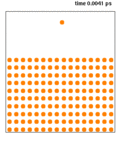In quantum chemistry and molecular physics, the Born–Oppenheimer (BO) approximation is the assumption that the wave functions of atomic nuclei and electrons...
30 KB (5,064 words) - 14:34, 31 July 2025
adiabatically parameterized by the nuclear positions (i.e., the Born–Oppenheimer approximation). A wide variety of approaches are used, including semi-empirical...
20 KB (2,260 words) - 13:17, 23 May 2025
approximation for molecular wave functions; work on the theory of positrons, quantum electrodynamics, and quantum field theory; and the Oppenheimer–Phillips...
172 KB (19,017 words) - 00:00, 25 July 2025
Franck–Condon principle (redirect from Franck-Condon approximation)
result of a series of approximations, principally the electrical dipole transition assumption and the Born–Oppenheimer approximation. Weaker magnetic dipole...
28 KB (3,503 words) - 12:55, 23 May 2025
Hartree–Fock method (redirect from Hartree-Fock approximation)
equation for a multi-electron atom or molecule as described in the Born–Oppenheimer approximation. Since there are no known analytic solutions for many-electron...
31 KB (4,739 words) - 23:21, 4 July 2025
The Born–Huang approximation is an approximation closely related to the Born–Oppenheimer approximation. It takes into account diagonal nonadiabatic effects...
3 KB (401 words) - 11:30, 15 May 2025
Adiabatic theorem (redirect from Sudden approximation)
pumping Adiabatic quantum motor Born–Oppenheimer approximation Eigenstate thermalization hypothesis Adiabatic process Born, M. and Fock, V. A. (1928). "Beweis...
46 KB (4,537 words) - 00:31, 29 July 2025
terms of some analytic functions. In the second step of the Born–Oppenheimer approximation the part of the full Coulomb Hamiltonian that depends on the...
38 KB (5,204 words) - 22:36, 14 April 2025
Density functional theory (redirect from Generalized gradient approximation)
of the treated molecules or clusters are seen as fixed (the Born–Oppenheimer approximation), generating a static external potential V, in which the electrons...
80 KB (10,626 words) - 17:26, 23 June 2025
energies of the whole molecule, electronic plus nuclear. The Born-Oppenheimer approximation is unsuited for describing the dihydrogen cation accurately...
29 KB (3,636 words) - 15:33, 21 May 2025
to a classical potential entails two main approximations. The first one is the Born–Oppenheimer approximation, which states that the dynamics of electrons...
84 KB (10,405 words) - 21:40, 30 July 2025
for infinite orthogonal group In chemistry and physics, the Born–Oppenheimer approximation Bolivia (ISO 3166-1 country code) .bo, Internet country code...
4 KB (552 words) - 23:00, 19 February 2025
solving the nonrelativistic Schrödinger equation within the Born–Oppenheimer approximation for a quantum chemical multi-electron system. Mathematically...
6 KB (844 words) - 13:36, 5 June 2025
the Born-Oppenheimer approximation, where the lighter electrons adjust instantaneously to the motion of the nuclei. Though the Born-Oppenheimer approximation...
17 KB (2,438 words) - 07:19, 8 April 2025
basis set, within the Born–Oppenheimer approximation (although schemes have also been drawn up to work without the BO approximation). One possible improvement...
28 KB (4,353 words) - 02:08, 11 December 2024
theoretical chemistry, the vibronic coupling is neglected within the Born–Oppenheimer approximation. Vibronic couplings are crucial to the understanding of nonadiabatic...
21 KB (2,752 words) - 18:03, 18 June 2025
rotational kinetic energy operator causing a breakdown of the Born–Oppenheimer approximation. This is to be contrasted with the Jahn–Teller effect which...
5 KB (656 words) - 18:40, 28 February 2024
Qbox (section Methods and approximations)
Functional Theory. Simulations can be performed either within the Born–Oppenheimer approximation or using Car-Parrinello molecular dynamics. The electronic ground...
8 KB (679 words) - 20:11, 27 June 2025
relating the energy of a molecule(s) to its structure (within the Born–Oppenheimer approximation). Qualitatively, the reaction coordinate diagrams (one-dimensional...
29 KB (3,603 words) - 15:06, 13 February 2024
are always in equilibrium when atoms move (the Born–Oppenheimer approximation). With this approximation, each asperity contact during sliding is equivalent...
88 KB (9,354 words) - 16:47, 20 July 2025
theoretical analysis of a molecule is simplified by use of Born–Oppenheimer approximation. Typically, rotational energies of molecules are smaller than...
11 KB (1,654 words) - 12:32, 18 July 2024
non-vanishing. In the vicinity of conical intersections, the Born–Oppenheimer approximation breaks down and the coupling between electronic and nuclear...
14 KB (1,809 words) - 10:09, 23 June 2025
(rovibrational) Hamiltonian that arises in the second step of the Born–Oppenheimer approximation. They make it possible to approximately separate rotation from...
17 KB (3,346 words) - 06:44, 16 September 2024
This is particularly important in quantum chemistry. In the Born–Oppenheimer approximation, the electronic molecular Hamiltonian is diagonalized on a set...
16 KB (2,614 words) - 09:49, 29 June 2025
height, resulting from pressure change. Adiabatic invariant Born–Oppenheimer approximation Adiabatic process Adiabatic ionization Adiabatic index Adiabatic...
1 KB (116 words) - 16:17, 15 January 2024
football (soccer) club Boa Island, in Northern Ireland Born-Oppenheimer Approximation, an approximation used in quantum chemistry and molecular physics Boa...
3 KB (478 words) - 09:28, 10 July 2025
states of a vibrationally excited molecule. Physics portal Born–Oppenheimer approximation Electrostatic deflection (molecular physics/nanotechnology)...
9 KB (994 words) - 15:39, 9 May 2025
electronic and vibrational (and rotational) energies; that is, the Born–Oppenheimer approximation applies. The overall molecular energy depends not only on the...
23 KB (3,040 words) - 11:27, 11 December 2024
causes a rigid shift of the Fermi sphere and a failure of the Born-Oppenheimer approximation since the electrons do not follow any more the ionic motion...
6 KB (781 words) - 10:12, 8 January 2025
electron, and the typical mass of a nucleus and leads to the Born–Oppenheimer approximation and the idea that the structure and dynamics of a chemical species...
29 KB (4,002 words) - 08:33, 27 December 2024









